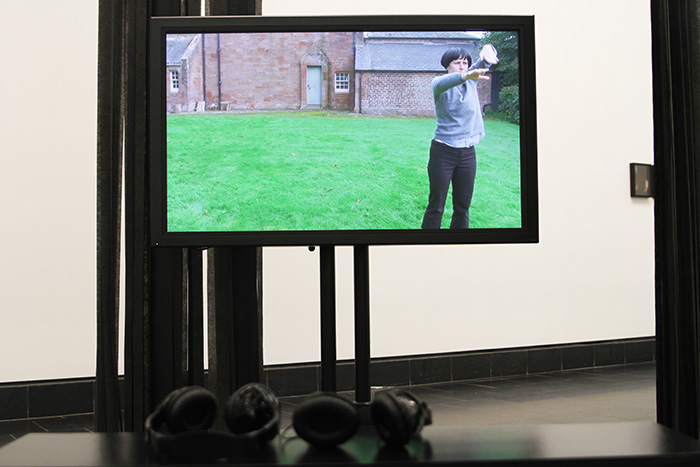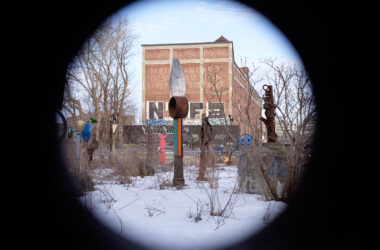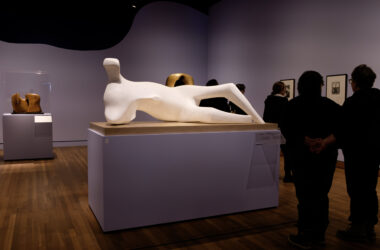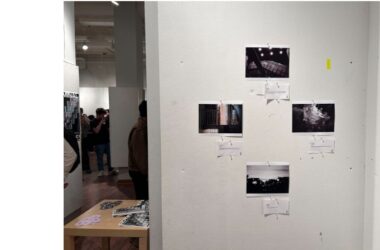Although she was born and raised in a small suburb outside of Quebec City, curators, critics, and fans cannot help but proudly introduce Julie Favreau as “one of Montreal’s very own.” Since graduating from Concordia in 2012, the 35-year-old artist has been the recipient of numerous grants and awards, including the Pierre Ayot Prize. Even so, no one can deny that two exhibitions showing in two of Montreal’s most reputable galleries is a feat worthy of the elegant reception thrown in her honour.
She Century: Tracer Son Portrait is an exhibition comprised of six pieces that premiered on Monday Sept. 26 at the Montreal Museum of Fine Arts (MMFA), followed by a second opening at the Darling Foundry gallery on Thursday Sept. 29. The title piece is a five-minute short film featuring Caroline Dubois, a dancer, choreographer, and friend of the artist. Although her background is primarily in sculpture, Favreau’s work has always incorporated aspects of performance art. In She Century, the focus fell somewhere between dance and theater.
“We worked for ten days in a studio,” Favreau explained in an interview at the exhibit’s opening event at the MMFA. “After those ten days in the dance studio, we kind of followed the movements and how she responded to the space. It was very planned.”
Favreau has always emphasized that her work is not performance art. Dubois’ movements are simple but deliberate, filmed from various angles and distances against the backdrop of an empty green field. Her interest is not in the subject themselves but the way in which they interact with their surroundings, something we do everyday without a second thought.
The space seems to lend itself to the theme of the show. Located in the Jean-Noël Desmarais Pavilion, the exhibit is housed in a small, narrow room. In the centre is the television playing She Century, surrounded by two sculptures, another film, and several photographs. The small space makes spectators uncomfortable—one can’t help but be aware of their own body in relation to the room. Audience members are unsure as to where to position themselves so as not to block the sculptures or the screen, and are hesitant to stand close to a piece.
Whether or not the show was designed to instill discomfort, it drove home the artist’s message in a way that was impossible to ignore. The exhibit forced the audience to pay attention to their environment, and the clumsy way in which they exist inside of it. Suddenly, the audience is at the mercy of their surroundings, rather than the other way around.
For an artist that specializes in sculpture, Favreau has an unexpected fascination with movement. In 2011, she completed a residency at the Quartier Éphémère in Paris to study dance in order to improve her choreography.
Her interest in choreography and motion seem to be woven into even the stationary pieces of the show. The largest sculpture is an upright three dimensional model version of a continuous looping structure that Dubois makes out of string in one scene of She Century.
“The question we were asking is, what would happen if the rope materialized into a sculpture?” Favreau explained, gesturing to the steel figure, which the label describes as a “drawing in space.” Although she stresses that each piece is separate, it appears as though none of them could exist in isolation. Each creation seems to come from a moment or object in the film, each transparent in its own simplicity. In one of the final scenes of She Century, Dubois is shown performing a sleight of hand trick. The young woman twists a white handkerchief into a closed fist, then, rubbing her palms together, makes it disappear while staring unwaveringly into the camera. This scene echoes the theme of the exhibition, forcing the viewer think twice about the way they interact with the objects that inhabit space around them.
Trailer – She century – 2015 from Julie Favreau on Vimeo.









